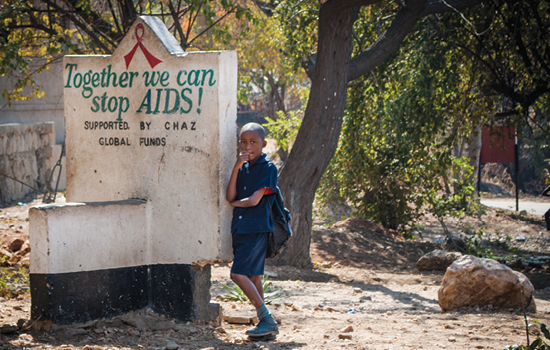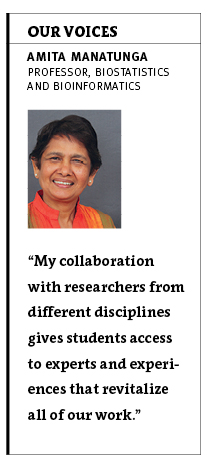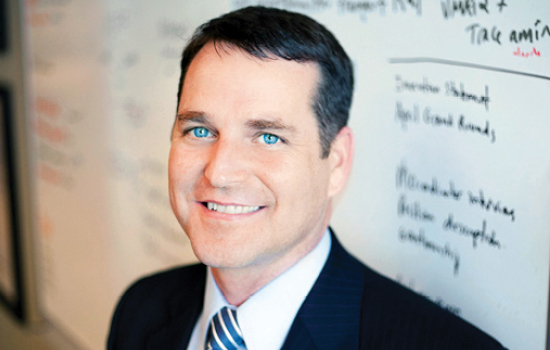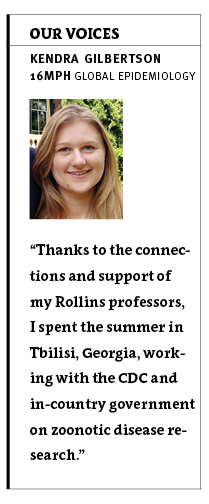Improving Health Through Discovery
By Martha Mckenzie
 |
||||||
 |
 |
 |
 |
|||
 Researchers at Rollins apply cutting edge concepts, theories, and methods to address public health challenges.
Researchers at Rollins apply cutting edge concepts, theories, and methods to address public health challenges.
 |
When people think about research, they often envision scientists laboring on theoretical endeavors for the sake of discovery itself.
There is nothing theoretical about the research being conducted at Rollins. Whether it’s finding ways to prevent the spread of AIDS among teens or determining how changes in air pollution levels affect visits to the ER, Rollins research is driven by the quest to find viable solutions to real problems for the betterment of public health.
While this focus has remained its defining feature, the school’s research program has expanded dramatically. Today Rollins supports projects in more than 50 countries, has a research portfolio of more than $75 million annually, and conducts a spectrum of discovery that spans from the molecular level to the population level and includes everything in between.
Rollins can link the vibrant growth of its research program to several factors. Its PhD programs have expanded to six, with 171 doctoral students currently enrolled.
The Rollins assistant professorship offers funds to promising scientists who are just getting their research off the ground. This incentive can often be the make-or-break factor in getting the best young faculty to commit to Rollins.
And, perhaps most important, the addition of three floors of laboratories with the construction of the Claudia Nance Rollins Building in 2010 has allowed the school to attract researchers that it couldn’t have considered going after before.
All of this translates into an expansion of the outstanding research for which Rollins is known.
Leading HIV/AIDS Research
 Each December 1, Emory hosts a portion of the AIDS Memorial Quilt in observance of World AIDS Day.
Each December 1, Emory hosts a portion of the AIDS Memorial Quilt in observance of World AIDS Day.
Emory physicians, scientists, and educators have played a key role in HIV/AIDS research from the earliest days of the epidemic, and today Emory is one of the top AIDS research organizations in the world.
This research falls under the umbrella of the Center for AIDS Research (CFAR), led by James Curran, Carlos del Rio, and Eric Hunter.
Curran had headed the CDC’s AIDS task force from the dawn of the epidemic until he became dean of Rollins in 1995.
While administratively based in Rollins, CFAR includes 150 researchers from across the university supported by almost $74 million in funding. Its research spans from basic science to actual treatment, and it reaches across the globe.
Clinical research. Atlanta is one of the epicenters of the modern HIV epidemic, and Emory facilities provide care to about 8,000 patients. Under the leadership of del Rio, Hubert Professor and chair of the Hubert Department of Global Health, clinical research is integrated into this care, with the primary focus on developing new therapeutics and improving the lives of those living with HIV.
Prevention research. Patrick Sullivan, epidemiology professor, is one of many researchers focused on prevention. He is pioneering new trials in preventing transmission among men who have sex with men and their steady partners.
Outside Rollins, scientists at the Emory Vaccine Center and Yerkes National Primate Research Center, including Harriet Robinson and Rama Amara, have developed vaccines against HIV that were successful in nonhuman primates and are now in early-stage clinical trials. More than 50 other scientists are working to develop both preventive and therapeutic vaccines.
And, of course, two of the antiretroviral drugs most commonly used in the world to treat HIV/AIDS were developed by Emory scientists.
Says Dean James Curran, "AIDS research at Rollins, and Emory as a whole, is vast, influential, and growing."
 Photo by Vanessa Burrowes 14MPH
Photo by Vanessa Burrowes 14MPH
Mortality and Mental Illness
Life expectancy has increased dramatically over the past half century, but this longevity is not shared equally. An analysis of 203 studies from 29 countries by Rollins researchers found that mental illness accounted for a 10-year shortening of life span and 8 million deaths worldwide each year.
While one might suspect suicide as the culprit, the study found that people with mental illness actually die of the same things everyone else dies of—cardiovascular disease and cancer—just in greater numbers.
So Rollins researchers are now working on various intervention studies to address the high rates of risky behaviors among the mentally ill.
"We are one of only seven public health schools in the country that has a formal mental health program, so we are in a unique position to study this issue," says Benjamin Druss, director of the Emory Center for Behavioral Health Policy Studies.
 |
The Weight of Chronic Disease Spending
Medicare spending is growing considerably each year, contributing to the overall rise in U.S. health care spending.
Ken Thorpe, chair of the Department of Health Policy and Management, and his colleagues wanted to find out how much of the rise in Medicare spending is due to the increasing prevalence of chronic diseases and then estimate how much of this is attributable to rising obesity rates.
It turns out, quite a bit on both fronts. Almost 40% of increased Medicare spending on diabetes is attributable to more people having diabetes, rather than increased spending per individual. An estimated 17% of total spending growth for diabetes is directly attributable to rising obesity. Similar results were found for other conditions.
What can be done? Currently, Medicare provides only two options: intensive behavioral therapy and bariatric surgery. Researchers recommend adding weight-loss drugs to the mix, as well as intensive care coordination.
On the Cutting Edge of the Exposome
 Gary Miller, director of HERCULES
Gary Miller, director of HERCULES
The mapping of the human genome promised to unlock the causes of diseases, lighting the path to prevention and treatments. Instead, genetics alone was found to account for only about 10% to 20% of diseases, with the remaining being due to the environment or a combination between genes and environment.
What scientists need is the environmental equivalent for the human genome.
That equivalent is the exposome. The concept is nothing short of the measurement of all of a person’s exposures over a lifetime and the body’s responses to those exposures.
To begin the process of this Herculean mapping task, the NIH awarded Rollins and its partner, Georgia Institute of Technology, a four-year $4 million grant to establish the HERCULES Center (Health and Exposome Research Center: Understanding Lifetime Exposures), the first exposome research center in the U.S.
As a core center grant, HERCULES provides infrastructure and facilities to support exposome-related research. Two years in, the center has already helped 20 different investigators with studies.
"The exposome is still in its infancy, but it’s potential is enormous," says Gary Miller, associate dean of research, director of the center, and professor of environmental health. "Having HERCULES here at Rollins has positioned us to be players on the national stage of cutting-edge environmental sciences research."
Leading and Learning in WASH

When Rollins researchers, along with CARE, the Government of Kenya, and several Kenyan collaborating organizations, found that improving school water, sanitation, and hygiene (WASH) access decreases absenteeism, increases enrollment, and reduces incidences of diarrhea and some parasitic infections, the Kenyan government took notice. It approved a school hygiene curriculum, increased its budget for WASH programs, and began providing free menstrual pads to all primary school girls.
"We are not doing this research in a vacuum," says Matthew Freeman, assistant professor in environmental health and lead researcher of the study. "We work to generate data that has direct policy implications and can inform how governments and donors can spend their money on WASH to improve the lives of schoolchildren."
Freeman’s study is but one of many in the Center for Global Safe Water, Sanitation, and Hygiene, which has earned a global reputation for its pioneering work. CGSW was the first WASH center established at a U.S. university, and Rollins was the first school in the country to offer a graduate certificate in WASH to MPH students.
Racism and Birth Outcomes

In the United States, African American women are much more likely to have low birth-weight babies than white women.
This imbalance holds true even when level of education, income, and access to prenatal care are taken into account. In fact, the gap widens the further up the socioeconomic ladder you go.
"When we looked at a very elite group—college-educated women married to college-educated men—we found African Americans had three times the rate of very low birth-weight babies as whites," says Carol Hogue, director of the Rollins Women’s and Children’s Center. Hogue hypothesizes that the birth weight disparity is explained by lifetime stress associated with racism experienced by African American women.
Her theory is borne out when one looks at black women who come to the U.S. as adults from Africa or the Caribbean. These women, controlled for socioeconomic factors, experience the same pregnancy outcomes as white women. Their daughters, however, are at a higher risk for low birth-weight babies.
As a result, African American women would be well served to identify ways to reduce stress and increase rest, be screened for depression, and have their nutritional status assessed—all before they get pregnant and during pregnancy, according to Hogue, the Jules and Uldeen Terry Professor of Maternal and Child Health.
Defeating Diabetes in India
 Venkat Narayan cuts the ribbon on a vehicle to be used in India by the Emory Global Diabetes Research Center.
Venkat Narayan cuts the ribbon on a vehicle to be used in India by the Emory Global Diabetes Research Center.
Diabetes is a tremendous global health burden, but it is particularly daunting in India.
Approximately 67 million men and women have diabetes, the second highest number of any nation in the world. Many develop the disease in their 30s and 40s, the most productive years of life.
Research about diabetes, however, occurs largely outside of India in high-income nations such as the U.S. What that research reveals may not translate directly to populations in low-resource settings.
For example, recent studies to come out of the Emory Global Diabetes Research Center (EGDRC) showed that deficient insulin secretion may contribute more specifically to diabetes in Asian Indians. "That suggests, in addition to modernization, there are factors related to the biology of diabetes in India that we don’t understand," says K.M. Venkat Narayan, the Ruth and O.C. Hubert Professor of Global Health and director of the EGDRC.
The solution lies in building a research base in India through training and collaboration. To date, the EGDRC has supported training for 25 U.S. researchers in India and 50 researchers from India and other countries at Rollins.
Earlier this year, the center joined forces to form an India-based Center for Control of Chronic Conditions. Partners include the Public Health Institute of India, the All India Institute of Medical Sciences, and the London School of Hygiene & Tropical Medicine. It will generate new research on diabetes, heart disease, cancer, mental health, and injuries by following more than 50,000 participants for multiple years throughout India and by completing trials of prevention and care improvement for these chronic conditions.
"Our agenda is so big," says Narayan. "Collaboration clearly is the way forward." —Pam Auchmutey
Cancer, Genetics, and Big Data
 |
In the past decade, cancer research has generated vast amounts of complex data on how genomics influence disease. A core group of experts from Rollins is helping make this data more meaningful for cancer scientists and patients.
These specialists comprise the Biostatistics and Bioinformatics Shared Resource (BBISR), which supports clinical, laboratory, population, and molecular study design and analysis at Emory’s Winship Cancer Institute. BBISR helps Winship researchers pinpoint why certain treatments and drug therapies may or may not work in light of various genomic, behavioral, and environmental risk factors. Rollins faculty in BBISR also lead their share of studies.
BBISR director Jeanne Kowalski is a biostatistician with expertise in clinical bioinformatics. Her work evolved from her experience in HIV/AIDS research, where she sought to understand why established drug therapies no longer worked for some patients. The key, she found, was related to the genetics of the virus itself. Kowalski’s active research focus continues in developing models that lead to an understanding of the molecular role, if any, for a patient’s response or non-response to treatment.
"Our goal," Kowalski says, "is to support research in ways that ensure that study results are accurate and effective, with the ultimate goal of improving treatment options leading to a better quality of life for cancer patients." —Pam Auchmutey

